2021-2022学年仁爱版英语七年级下册期中总复习课件(共有PPT70张)
文档属性
| 名称 | 2021-2022学年仁爱版英语七年级下册期中总复习课件(共有PPT70张) |  | |
| 格式 | pptx | ||
| 文件大小 | 14.1MB | ||
| 资源类型 | 教案 | ||
| 版本资源 | 仁爱科普版 | ||
| 科目 | 英语 | ||
| 更新时间 | 2022-04-17 08:16:19 | ||
图片预览

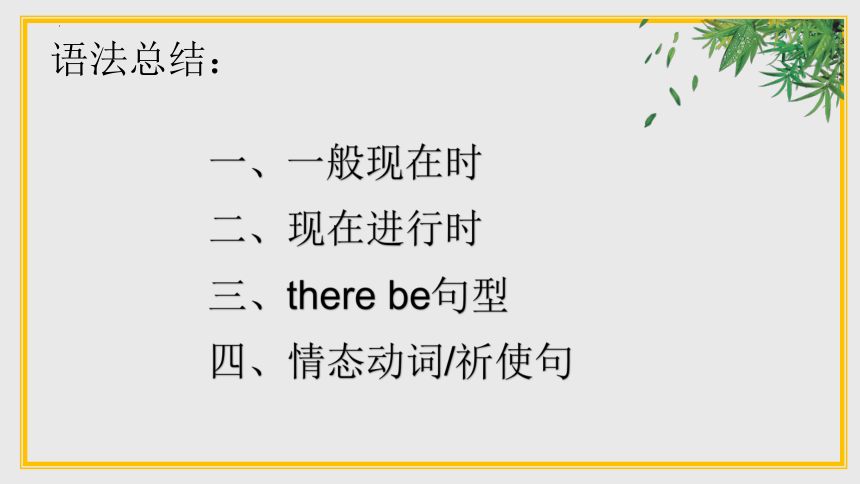
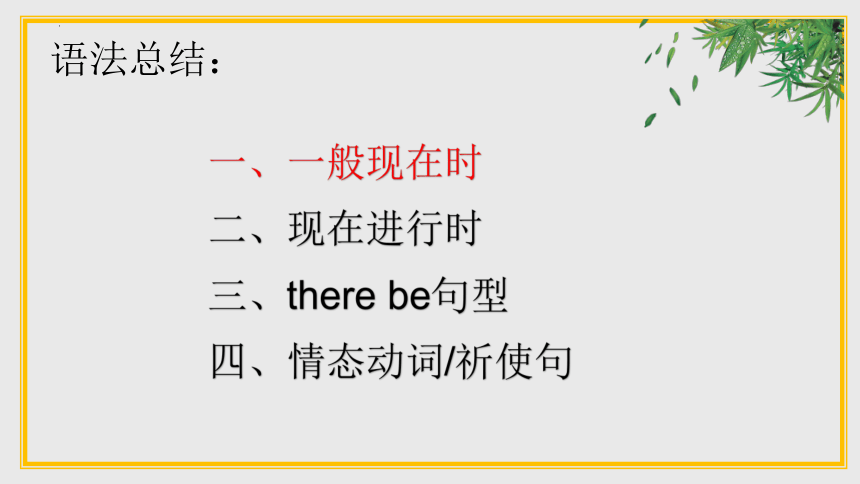

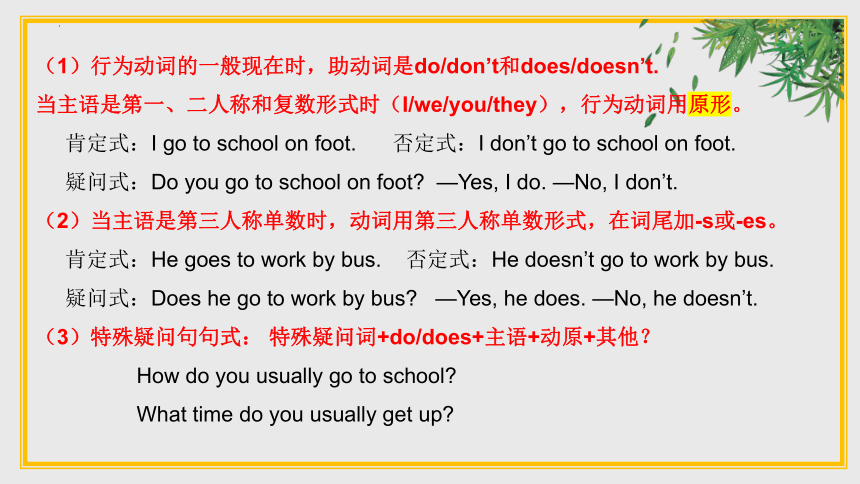
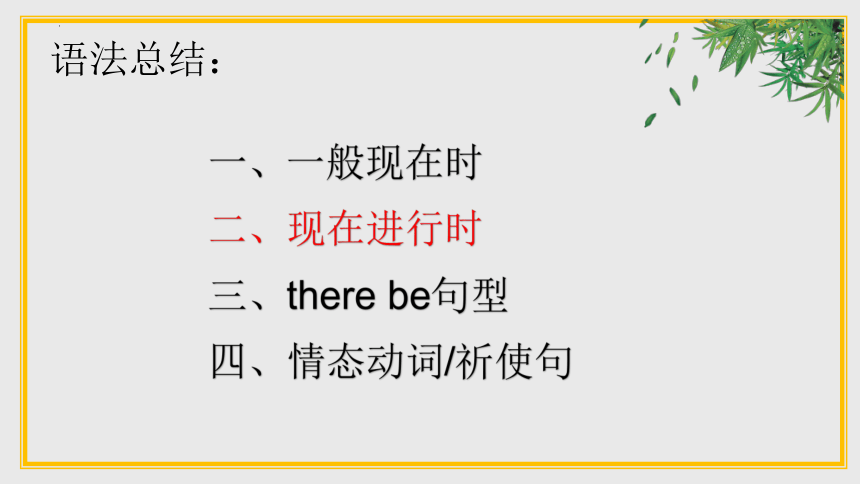
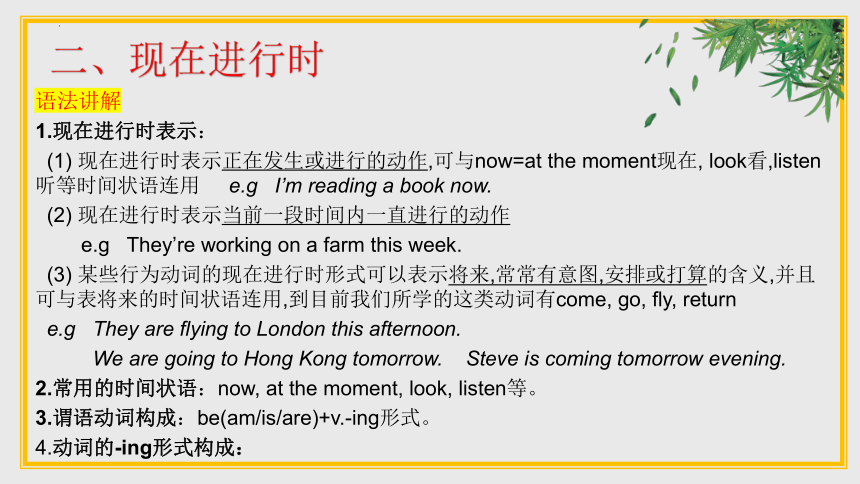


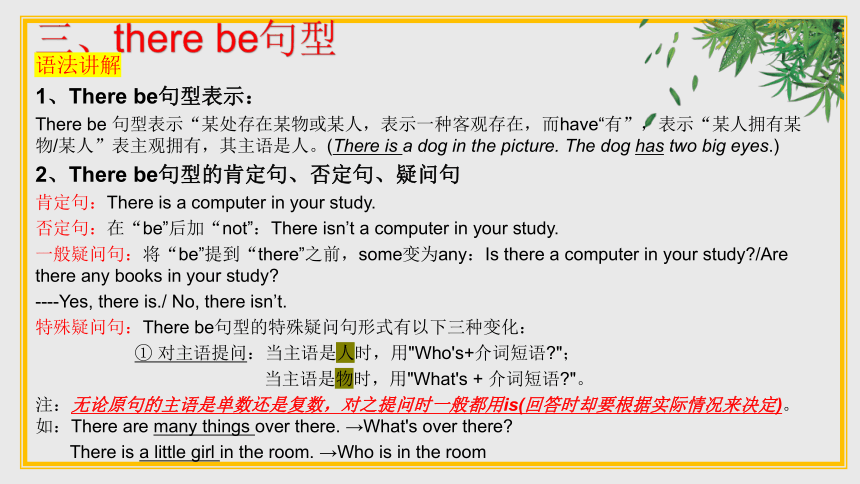

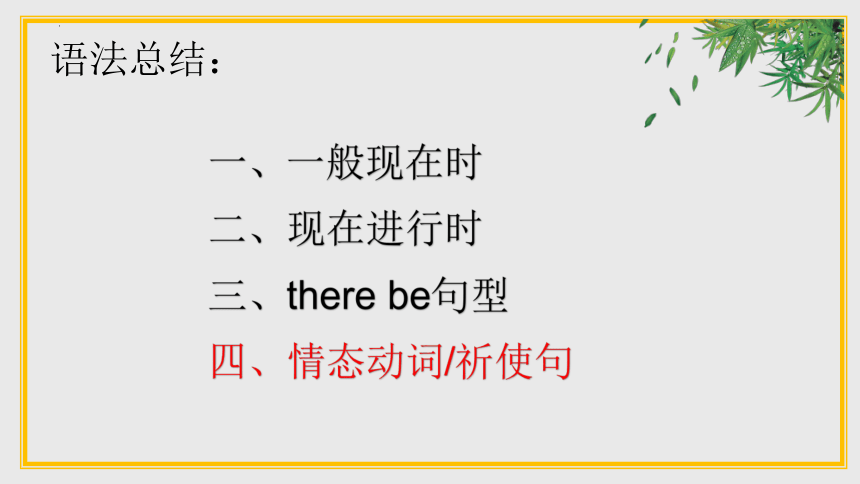
文档简介
(共70张PPT)
七 年 级 下 册 期 中 复 习
语法总结:
一、一般现在时
二、现在进行时
三、there be句型
四、情态动词/祈使句
语法总结:
一、一般现在时
二、现在进行时
三、there be句型
四、情态动词/祈使句
一、一般现在时
1.语法讲解
一般现在时表示:(常与频度副词never, seldom, sometimes, often, usually, always等连用)
(1)现在所处的状态。Jane is at school.
(2)经常或习惯性的动作。I often go to school by bus.
(3)主语具备的性格和能力。He likes playing football.
(4)客观真理。The earth goes round the sun. 地球围着太阳转。
常用的时间状语:often, always, usually, sometimes, every day等等。
(1)行为动词的一般现在时,助动词是do/don’t和does/doesn’t.
当主语是第一、二人称和复数形式时(I/we/you/they),行为动词用原形。
肯定式:I go to school on foot. 否定式:I don’t go to school on foot.
疑问式:Do you go to school on foot —Yes, I do. —No, I don’t.
(2)当主语是第三人称单数时,动词用第三人称单数形式,在词尾加-s或-es。
肯定式:He goes to work by bus. 否定式:He doesn’t go to work by bus.
疑问式:Does he go to work by bus —Yes, he does. —No, he doesn’t.
(3)特殊疑问句句式: 特殊疑问词+do/does+主语+动原+其他?
How do you usually go to school
What time do you usually get up
语法总结:
一、一般现在时
二、现在进行时
三、there be句型
四、情态动词/祈使句
二、现在进行时
语法讲解
1.现在进行时表示:
(1) 现在进行时表示正在发生或进行的动作,可与now=at the moment现在, look看,listen听等时间状语连用 e.g I’m reading a book now.
(2) 现在进行时表示当前一段时间内一直进行的动作
e.g They’re working on a farm this week.
(3) 某些行为动词的现在进行时形式可以表示将来,常常有意图,安排或打算的含义,并且可与表将来的时间状语连用,到目前我们所学的这类动词有come, go, fly, return
e.g They are flying to London this afternoon.
We are going to Hong Kong tomorrow. Steve is coming tomorrow evening.
2.常用的时间状语:now, at the moment, look, listen等。
3.谓语动词构成:be(am/is/are)+v.-ing形式。
4.动词的-ing形式构成:
4.动词的-ing形式构成:
5.现在进行时态的肯定、否定和疑问式。
(1)肯定句:主语+be+doing+sth I am running. He/She is running.
(2)否定句:主语+be+not+doing+sth I’m not running. He/She isn’t running.
(3)一般疑问句:Be+主语+doing+sth 回答:Yes,主(代)+be /No,主(代)+be+not
Are you running —Yes, I am./—No, I am not.
Is he/she running —Yes, he/she is./ —No. he/she isn’t
(4)特殊疑问句: What+be+主语+doing
语法总结:
一、一般现在时
二、现在进行时
三、there be句型
四、情态动词/祈使句
三、there be句型
语法讲解
1、There be句型表示:
There be 句型表示“某处存在某物或某人,表示一种客观存在,而have“有”,表示“某人拥有某物/某人”表主观拥有,其主语是人。(There is a dog in the picture. The dog has two big eyes.)
2、There be句型的肯定句、否定句、疑问句
肯定句:There is a computer in your study.
否定句:在“be”后加“not”:There isn’t a computer in your study.
一般疑问句:将“be”提到“there”之前,some变为any:Is there a computer in your study /Are there any books in your study
----Yes, there is./ No, there isn’t.
特殊疑问句:There be句型的特殊疑问句形式有以下三种变化:
① 对主语提问:当主语是人时,用"Who's+介词短语 ";
当主语是物时,用"What's + 介词短语 "。
注:无论原句的主语是单数还是复数,对之提问时一般都用is(回答时却要根据实际情况来决定)。如:There are many things over there. →What's over there
There is a little girl in the room. →Who is in the room
② 对地点状语提问:
提问地点用"Where is / are+主语 "
答语:“There + be+主语+地点状语”表示“某处有某物”;
语法总结:
一、一般现在时
二、现在进行时
三、there be句型
四、情态动词/祈使句
四、情态动词/祈使句
1、情态动词表示:
情态动词本身有一定意义,但不完整,因此不能在句子中独立作谓语,只能和动词原形一起构成谓语,表示说话人对某一动作或状态的语气或态度。情态动词通常没有人称和数的变化。
2、常见的情态动词有:
can, may, must, should, will
3、情态动词后跟动词原形
You should be careful. You must be a good boy.
四、情态动词/祈使句
语法讲解
1、祈使句表示:
表示请求、命令、禁止、劝告或建议的句子,特点是省略了主语。
2、祈使句特点
祈使句无主语, 主语you常省去; 肯定形式以动词原形当开头, 否定形式在谓语动词前do not或don't; 朗读应当用降调, 句末常标感叹号。
3、祈使句肯定结构:
3、祈使句肯定结构:
<1>.Do型(即:动词原形(+宾语)+其它成分)。如:Please have a seat here. 请这边坐。
<2> Be型(即:Be + 表语(名词或形容词)+其它成分) 如:Be a good boy! 要做一个好孩子!
Be careful. 小心!
<3>.Let型(即:Let + 宾语 + 动词原形 + 其它成分) 如:Let me help you. 让我来帮你。
4、祈使句否定结构:
<1> Do型和Be型的否定式都是在句首加don't构成。
如:Don't forget me! 不要忘记我!
Don't be late for school! 上学不要迟到!
Don’t play on the street. 不要在路上玩!
<2>.Let型的否定式有两种:
“Don‘t + let + 宾语 + 动词原形 + 其它成分”
“Let + 宾语 + not + 动词原形 + 其它成分”
如:Don't let him go. / Let him not go. 别让他走。
<3> 有些可用no开头,用来表示禁止性的祈使句。
如:No smoking! 禁止吸烟!No fishing! 禁止钓鱼!
Unit 5 Topic 1 I usually come to school by subway
一、常用短语
交通方式表达:by+交通工具单数名词 /take +a/an/the+交通工具单数名词
二、语法
一般现在时及频度副词用法
三、技能
能就交通方式和日常活动的频度进行交流。
四、重点单词、句型
Go to …on foot =walk to…
Go to …by bus=take a bus…
对某事发生频度的提问:How far…
重点短语
1. at the school gate在学校大门口
2. on weekdays 在平日 ,在工作日
3. on weekends=on the weekend在周末
4. after school 放学后
5. after class 下课后
6. after breakfast / lunch / dinner
早餐 / 午餐 / 晚餐后
7. in one’s free time在某人空闲时间
8. have a rest 休息一下
9. read books 读书
10. go swimming 去游泳
11. listen to music 听音乐
12. watch TV 看电视
see a movie 看一场电影
13. do one’s homework 做作业
14. go to the zoo / park 去动物园 / 公园
15. once a week 一周一次
16. every day 每天
17. have classes /have class 上课
18. for a short time 一会儿
19. go to bed 上床睡觉
e on 快点,加油,来吧
21. get up 起床
22. talk with / to sb.与某人谈话
23. by subway/bus/bike… 坐地铁/公交坐/自行车
take a bus/subway, 乘坐公交车/地铁
ride a bike 骑自行车 on foot 步行
24. go to school 去上学
重点句子
1. -Happy New Year! -Happy New Year!/ The same to you. --新年好!--新年好/你也是。
2. -Your new bike looks very nice. -Thank you. –你的自行车看起来很漂亮。--谢谢。
3. -How do you usually come to school —I usually come to school by subway.
–你通常怎么来 学校—我通常坐地铁来学校
4. You mean you usually come to school by underground
5. The early bird catches the worm. (谚语) 笨鸟先飞
6. Classes begin at eight. =Class begins at eight. 八点上课
7. At a quarter past five, she takes the subway home. 在五点十分,她乘地铁回家。
8. After dinner, she often does her homework and then watches TV for a short time.
9. We’d like to know about the school life of American students. 我们想了解美国学生的学校生活。
10. –What time is school over - School is over at about three o’clock.什么时候放学?大约三点放学。
11. I'm sorry we have no more time. 很抱歉我们没有更多的时间了
12. Nice talking to you.很高兴和你聊天。
重点详解
1. by+交通工具,表示使用某种交通方式,中间不加限定词,乘坐交通工具:(by car/bus/train/ship)
I always come to school by bus.
巧辩异同on foot 与 walk
on foot “走路”,是介词短语,不能作谓语,只作方式状语,位于句末。walk “走路”,是动词,可以作谓语。
go (to)…on foot= walk (to)… I often go to school on foot. =I often walk to school.
类似的还有:
take a/the bus (to) = go (to) …by bus ride a bike (to)= go (to)…by bike
take a/the subway(to) = go (to)…by subway
go (to)…. by car = drive a car (to)
go (to)… by plane = fly (to)
<1>当后面的地点为home,here,there 时,省略to。
<2>如果交通工具前有a, the, my 等限定词,就不能用by,而是用in或是on.
on+大型封闭式工具(on the bus/ train/ship/plane)=by bus/train/ship/plane
In +小型封闭交通工具(in a car/taxi)=by car/taxi
e.g. I go to school by bus.=I go to school on the bus.
2. It’s time for sth. “该做某事了”=It’s time to do sth./ It’s time for doing sth.
It’s time for class. =It’s time to have class. =It’s time for having class.
3. look/sound +adj (look感官动词,系动词) 看起来/听起来…
His mother looks very young. That sounds interesting.
look的短语 look the same看起来一样 look like看起来像……
look for寻找 look after =take care of 照顾,照料
4. do one’s homework 做家庭作业(注:one’s 要随主语的变化而变化,常用形容词性物主代词my, your, their, our, his, her等)。 do my homework at school 在学校做作业
5. want to do sth. “想做某事”
know/learn about “了解,知道关于…”。
we want to know about the school life of American students.
我们想了解一下美国学生的学校生活。
6. 巧辩异同
a few+可数名词 (肯定);一点,一些; few+可数名词:(否定)很少,几乎没有
a little+不可数名词(肯定);一点,一些; little +不可数名词:(否定)很少,几乎没有
e.g. He has a few friends. 他有几个朋友。He has few friends. 他几乎没有朋友。
e.g. I can speak only a little Chinese. 他能说一点汉语 。 They has little money. 他们没有什么钱?
7. go+v.-ing 表示去做某事,类似: go fishing 去钓鱼 go shopping 去买东西
go boating 去划船 go skating 去滑冰 go swimming 去游泳 go traveling 去旅游
and so on “等等”,表示还有很多。
They often play basketball or coccer, go swimming and so on.
8. (1). How often 多久一次(对频度进行提问)
答语常用频度副词always> usually>often> sometimes>seldom>never等或单位时间内的次数,表示频率的短语:次数+单位时间
e.g. : once a week一周一次 twice a month每月两次three times a year每年三次
--How often do you go to the library 你多久去一次图书馆?
--Once/twice/three times/four times a week/month/year.
(2).How far多远(表示距离)
How far is it from here to the zoo --It’s 6 kilometers (away from here).
(3).How long多长(对时间进行提问,持续多长时间(多久)/东西的长度(多长)
-How long did he stay here -He stayed there for about two weeks.
-How long is the rode -About 500 km.
-How long is the box?-It’s 4 meters long.
9. over (形容词) 结束 School / Class is over. What time is the class over
10. begin 现在分词: beginning 过去式: began What time does the class begin
11. listen to 听(动作), hear 听见(结果)
冠词用法
1. 弹乐器前要带定冠词the,而进行球类运动则不带the。
play +棋类/球类/牌 下……棋,打……球 play soccer/basketball
play the +西洋乐器 弹/拉……乐器 play the guitar/piano
2.序数词,前面要用定冠词the。
on the second floor
3.三餐前面不用冠词。
have breakfast/lunch/supper
1. 在学校大门口
2. 在平日 ,在工作日
3. 在周末
4. 放学后
5. 下课后
6. 早餐 / 午餐 / 晚餐后
7. 在某人空闲时间
8. 休息一下
9. 读书
10. 去游泳
11. 听音乐
12. 看电视
看一场电影
13. 做作业
14. 去动物园 / 公园
15. 一周一次
16. 每天
17. 上课
18. 一会儿
19. 上床睡觉
20. 快点,加油,来吧
21. 起床
22. 与某人谈话
23. by 坐地铁/公交坐/自行车
take 乘坐公交车/地铁
骑自行车 步行
24. 去上学
过关短语
过关句子
1. --新年好!--新年好/你也是。
2.–你的自行车看起来很漂亮。--谢谢。
3.–你通常怎么来 学校—我通常坐地铁来学校
4. 你的意思是你通常乘地铁来学校?
5. (谚语) 笨鸟先飞
6. 八点上课
7. 在五点十分,她乘地铁回家。
8. 晚饭后,她常常做家庭作业,然后再看一会电视。
9. 我们想了解美国学生的学校生活。
10. 什么时候放学?大约三点放学。
11. 很抱歉我们没有更多的时间了
12. 很高兴和你聊天。
过关重难点
1、某种交通方式表达
2、该做某事了
3、a few/a little few/little 区分
4、how ofen/how far/how long 的含义,分别是对什么的提问
完成任务
1、过关单词
2、过关短语
3、过关句子
4、写一篇描述自己一天的短文“My Day”
Unit 5 Topic 2 A few students are running around the playground
一、常用短语
a few, do some cleaning,look for,on time,show sb.around,have lessons,
at the back of…, talk to sb.
二、语法
现在进行时的用法
三、技能
1、正确表达现在进行的动作,借阅图书和寻找物品的交际用语
2、会写失物招领和寻物启事
四、重点短语、单词、句型
重点短语
1. make cards 制作卡片
2. on the playground 在操场上
3. in the library 在图书馆
4. in the gym在体育馆
5. on the shelf 在书架上(shelves 复数)
6. on time 准时
7. at the Lost and Found 在失物招领处
8. run around the playground绕着操场
9. over there 在那边
10. have a soccer game 举行足球比赛
11.show sb. around …领某人参观
12. have an English class上英语课
13. draw pictures 画画
14. clean the blackboard 擦黑板
15work on a computer 从事电脑工作
16. play games 玩游戏
17. talk to/with sb. 和某人谈话
重点句子
1. Are you doing your homework Yes, I am./No, I am not. --你正在做家庭作业吗?--是的,我是。/不,我不是。
2. What is he doing ---- He is cleaning the classroom. --他正在作什么?--他正在打扫教室。
3. How long can I keep them You can keep them for two weeks. --我能借他们多长时间?--你能够借它们两周。
4. -You must return them on time. -Sure, I will. --你必须按时归还它们。--当然,我会的
5. -Sorry, I don’t have any. -Thank you all the same. --抱歉,我没有一些。--仍然感谢你。
6. Michael and Jane are talking on the telephone. --迈克尔和简正在打电话。
7.I’m marking cards,but it’s boring. 我正在制作卡片,但它是无聊的。
8.--Would you like to play basketball with me —Good idea! --你想要和我一起打篮球吗?--好主意!
9.—What is she doing – She is reading. --她正在做什么?--她正在读书。
10.The girl is looking for the books on the shelves. 这个女孩正在书架上找书。
11.Helen isn’t dancing with them. 海伦没有和他们一起跳舞。
12.Sis cleaning the blackboard at the back of the classroom. 她正在教室后面擦黑板。
现在进行时的句子
重点详解
1. 与how相关的短语
how often多常 how many多少 how much多少钱 how old多大
2. And you must return them on time.你必须按时归还它们。Return意为“归还,回归”
① return sth. to sb.把某物归还某人=give back sth. to sb.
② return to“回到…”,相当于come back to…
3. talk“交谈”,常用的短语talk to/with sb.“与某人交谈” talk about sth.“谈论某事”
He is talking to a Japanese girl on the Great Wall.
4. look for“寻找”,强调寻找的过程;
find“找到” 发现,强调找的结果。
I can’t find my purse and I am looking for it.
5. Read, see ,look and watch
look(at) 看,表动作,后面需加介词at才能跟宾语,指看的动作,
see 看见,指看的结果,
read 常指看书、看报纸等,表示阅读
watch 看比赛、电视
e.g I can an apple on the table。 I want to the film with you。
,there is a kite flying in the sky。 Please the blackboard carefully。
Tv too much is bad for your health。
重要句型总结
现在进行时: 谓语构成,肯定句、否定句,一般疑问句,特殊疑问句。
1. What’s in+sth 表示哪里有什么东西
e.g What’s in your wallet 钱包里有什么东西
2. Here are some photos of his.
名词+Of+名词性物主代词/名词所有格----双重所有格
e.g a friend of Sam’s 萨姆的一个朋友 a friend of mine 我的一个朋友
3. love/like doing sth Love/like to do sth一
1. 制作卡片
2. 在操场上
3. 在图书馆
4. 在体育馆
5. 在书架上
7. 准时
8. 在失物招领处
9. 绕着操场
10. 在那边
11. 举行足球比赛
过关短语
12. 领某人参观
13. 上英语课
14. 画画
15. 擦黑板
16. 从事电脑工作
17. 玩游戏
18. 和某人谈话
过关句子
1. --你正在做家庭作业吗?--是的,我是。/不,我不是。
2. --他正在作什么?--他正在打扫教室。
3. --我能借他们多长时间?--你能够借它们两周。
4. --你必须按时归还它们。--当然,我会的
5. --抱歉,我没有。--仍然感谢你。
6. --迈克尔和简正在打电话。
7. 我正在制作卡片,但它是无聊的。
8--你想要和我一起打篮球吗?--好主意!
9--她正在做什么?--她正在读书。
10. 这个女孩正在书架上找书。
11. 海伦没有和他们一起跳舞。
12. 她正在教室后面擦黑板。
完成任务
1、过关单词
2、过关短语
3、过关句子
4、默写单词、短语、句子
Unit 5 Topic 3 My school life is very interesting
一、常用短语
Think of, a little, each other, work on, outdoor activity, between…and…,from…to…
二、语法
1、一般现在时和现在进行时之间的差别
2、现在进行时的特殊疑问句
三、技能
1、表达对不同学科的喜好和评价,并陈述原因。2、读懂校园海报、校园生活的文章 3、英文书信格式
四、重点单词、句型
重点短语
1. have a music/Chinese/math class 上一节音乐/语文/数学课
2. talk about 谈论
3. on that day 在那天 on Wednesday 在周三
4. On Wednesdays 每逢周三
on Wednesday morning 在周三上午
5. easy and interesting 容易又有趣
6. difficult and boring 又难又乏味
7. help each other 互相帮助
8. work on math problems 做数学题
9. be friendly to sb. =be kind to sb. 对某人友好
10. between…and… 在……之间…
11. learn(…)from… 向…学习…/从…中学…
12. learn about the past了解/学习过去
13. every Tuesday and Thursday每周二和周四
15. different kinds of… 不同种类的…
16. from…to… 从……到……
17. tell sb. about sth.告诉某人关于某事
重点句子
What day is it today?---It’s Sunday. --今天星期几?--今天是周日
(在英语国家每周的第一天是星期天而不是星期一)
2. What class are they having They are having a music class. --他们正在上什么课?--他们正在上一节音乐课。
3. What time does the next class begin At ten o’clock. --下节课什么时候开始?--十点
What time is the class over The class is over at 11 o’clock. --这节课什么时候结束?--这节课在11点结束
4. What do you think of math = How do you like math 你认为数学怎么样?
----It’s difficult and boring. --它又难又乏味
5. Why (为什么)do you like English Because(因为)it’s easy and interesting. --你为什么喜欢英语?--因为它又容易又有趣。
7. What subject (学科)do you like best I like history best. --你最喜华哪个学科?--我最喜欢历史。
What’s your favorite subject My favorite subject is history. --你最喜欢的科目是什么?--我最喜欢的科目是历史。
8. At school, my teachers and classmates are very friendly to me. --在学校,我的老师和同学们对我很友好。
9. I study Chinese, English, politics, geography and some other subjects. --我学习语文、英语、政治、地理和一些其他的科目。
10. English is my favorite subject. --英语是我最喜欢的科目。
11. I also like P.E and music. = I like P.E and music , too. --我也喜欢体育和音乐。(注意also和too的位置)
12. Can you tell me something about it --你能告诉我关于它的一些事情吗?
重点详解
1. 询问星期几用What day is it…?回答:It’s Wednesday/Sunday…。
与what有关的短语:what class什么班 what color什么颜色what time几点
What’s the date… 是对日期(几号)的提问。
What day is it today —It’s Monday.问星期
What’s the date today —It’s the May 1st.问具体日期。
What do you do —I’m a teacher.
What does he look like —He is tall/He has a small mouth.问外貌
What’s she like —She is kind/friendly..问性格。
2. How many+可数名词的复数形式;How much+不可数名词。
How many lessons does he have every weekday
3. in+时间段(in the morning/afternoon/evening
季节/月份/年份前也用in:in Spring/Oct/in September,2008)
in用于泛指一天的上午,下午,晚上等,也用于某个较长的时间,如年,月,季节等,还可以表示“从现在起一段时间以后”in a week 一周后
at+时间点[钟点时(刻)](at 6 o’clock)
at noon at night at midnight at this time of day
on+具体某一天(具体日期、节日前/具体日期上午,下午,晚上)on Sep 10th /on Women’s Day/ on a rainy day/on Monday morning/on May 1st afternoon)
在星期几常用on,在具体点钟前用at.
重点详解
4. What do you think of … = How do you like… 你认为……怎么样?
What’s your favorite subject = Which subject do you like best 你最喜欢什么科目?
5. Why do you like it 你为什么喜欢它?
--Because it’s easy and interesting.因为它简单而有趣。
用why提问必须用because回答。Why ----Because it’s interesting.
如果表示“你为什么不”用 Why not like English 或Why don’t you like English
6. be friendly to sb. 对某人友好 My teachers are very friendly to me.
注: friendly是形容词 “友好的”“友善的”,而不是副词。
7. a lot 可以表示“非常,十分”。I can learn a lot from it.我能从中学到很多东西。
修饰名词时,必须用a lot of=lots of, 即可修饰可数名词,也可修饰不可数名词。
11. You must like English very much. 你一定非常喜欢英语。must在这里表示肯定推测。
12. It’s time for (doing) sth.= it’s time to do sth. 该做某事了
It’s time for class.上课的时间到了.
过关短语
1. 上一节音乐/语文/数学课
2. 谈论
3. 在那天 在周三
4. 每逢周三
在周三上午
5. 容易又有趣
6. 又难又乏味
7. 互相帮助
8. 做数学题
9. 对某人友好
10. 在……之间…
11. 向…学习…/从…中学…
12. 了解/学习过去
13. 每周二和周四
14. 不同种类的
15. 从……到……
16. 告诉某人关于某事
过关句子
--今天星期几?--今天是周日
2. --他们正在上什么课?--他们正在上一节音乐课。
3. --下节课什么时候开始?--十点
--这节课什么时候结束?--这节课在11点结束
4. --你认为数学怎么样?
--它又难又乏味
5. --你为什么喜欢英语?--因为它又容易又有趣。
7. --你最喜华哪个学科?--我最喜欢历史。
--你最喜欢的科目是什么?--我最喜欢的科目是历史。
8. --在学校,我的老师和同学们对我很友好。
9. --我学习语文、英语、政治、地理和一些其他的科目。
10. --英语是我最喜欢的科目。
11.--我也喜欢体育和音乐。
12. --你能告诉我关于它的一些事情吗?
过关重点语法
1、询问星期几
2、How many 与How much的提问
How many
How much
3、in /on/at后跟时间的却别
in
on
at
4、你认为……怎么样
5、用why提问必须用because回答
6、某人友好
7、该做某事了
完成任务
1、过关单词
2、过关短语
3、过关句子
4、写一篇介绍你学校生活“My school life”的短文。
(提纲:1.一天上多少节课?2.学校上什么课程?3.你最喜欢的科目是哪个?4.放学后你做什么?5.你认为你的学校生活怎么样?)
Unit 6 Topic 1There is a study next to my bedroom
一、常用短语
next to , and so on ,at the first/second floor, in front of , in the front of ,
put away , look after , in the center of , at the back of , on the left/right of.
二、语法
1.There be句型的用法
2.介词in,on,under,behind,near及词组next to,in front of等的用法
三、技能
1.对房间、室内摆设进行交流和评价;2.读懂房间布局;3.写出介绍自己家的小短文
四、重点单词、句型
肯定句,否定句,一般疑问句,特殊疑问句
Be遵循___原则。
come in
重点短语
1.On the second floor 在二楼
2.Next to 挨着
3.Why not +V原… =Why don’t you +V原…
4.go upstairs上楼
5.have a look (at sth.) 看看(某物)
6. in the front of the classroon
在教室(里面的)前面
in front of the classroom
在教室(外面的)前面
at the back of the classroom 教室(内部)后面
behind the house 房子(外面的)后面
8.talk about+n/v-ing谈论,议论,讨论某事
talk with sb. 与某人交谈
9.put them away (代词只能放中间)把他们收拾好
10. play with sb.“与某人一起玩”
11.
In the tree(外物附着)在树上
On the tree 树本身长出来的花,树叶等
on the wall在墙上
in the wall在墙里
12.on the left/right of 在...的左边/右边
13.write ( a letter) to sb.给......写信
重点句子
1.—Welcome to my new home,Maria --欢迎来到我的新家 ,玛瑞亚。--谢谢,简
--Thanks,Jane.
2.--Where is your bedroom --你的卧室在哪里?
--It’s on the second floor.There is a study next to my bedroom. --它在二楼,有一个书房紧挨它。
3.—Why not go upstairs and have a look --为什么不上楼看看呢?
--Let’s go. --走吧
4.—Are there any English books in your study --有一些英语书在你书房吗?
--Yes,there is. --是的,有一个
5.—Is there a computer in your study --有一个电脑在你书房吗?
--Yes,there is. --是的,有一个
6.—What is on your desk --你的桌子上有什么?
--My computer is on the desk.There are also some books and a lamp.
—我的电脑在桌子上,也有一些课本和一个台灯。
7.—Come in,please. --请进来
8.Don’t put it/them there.Put it/them away,please. ---别把它/他们放在这。把它/他们收起来放好。
9.You must look after your things. --你必须照顾好你的东西
10.—How many model planes are there --有多少模型飞机在那儿?
--There are three. --有三个。
重点详解
1.It’s on the second floor. 在哪一层楼,用介词on。on表示在……上面。
second是序数词,前面要用定冠词the, 意为第二(的)。
on the first floor美式英语一楼floor地板,此处指“楼房的层”。
巧辩异同 two与second
two是基数词,second是序数词,“第二”或“第二的”,指排列顺序。
2. have a look看看。后面接名词时要用at. 如have a look at your watch.
3. put away 把……放好
Don’t put them here. Put them away.别把它们放在这儿,请收起来放好。
4. look after“保管,照顾”,相当于take care of.‘’
look at看…… look like看起来像…… look for寻找 look the same看起来一样
You must look after your things.你必须保管好你的东西。
5. like to do sth 和 like doing sth 二者都表示"喜欢做某事",
例: She likes swimming.她喜欢游泳。
I like eating fish .
I love playing on the computer in the study. 我喜欢在书房玩电脑。
(love doing sth.=like doing sth. 喜欢做某事)
重点详解
6. write a letter to sb. 给某人写信 write a letter to do sth. 为了……而写信
get a letter from sb.收到某人的来信
I’m very glad to get a letter from you.我很高兴收到你的来信。
7. Welcome to my new home.【home作n.】 (对比Welcome home【home作adv.】)
8. so/too many+可数名词复数=many eg: There are so many books in the desk.
so/too much+不可数名词 =much There is so much water in the river.
much too+adj ==too太... I’m much too tired.我太累了
9. 方位短语:
in the center of=in the middle of在...中间
in front of 在...前面(外部)in the front of(内部)在...前面
at the back of 在...后面
on the left/right of在...的左边/右边
next to 紧邻
过关短语
1. 在二楼
2. 挨着
3.为什么不……
4. 上楼 下楼
5. 看看(某物)
6. n.书房 v.学习
7.
在教室(里面的)前面
在教室(外面的)前面
教室(内部)后面
房子(外面的)后面
8. 谈论,议论,讨论某事
与某人交谈
9. 把他们收拾好
11. 与某人一起玩
12. (外物附着)在树上
(树本身长出来的花,树叶等)在树上
在墙上(墙表面上)
在墙里(墙里边嵌)
13. 在...的左边/右边
14. 给......写信
1.--欢迎来到我的新家 ,玛瑞亚。--谢谢,简
2.--你的卧室在哪里?
--它在二楼,有一个书房紧挨它。
3--为什么不上楼看看呢?
--走吧
4.--有一些英语书在你书房吗?
--是的,有一个
5--有一个电脑在你书房吗?
--是的,有一个
6.--你的桌子上有什么?
—我的电脑在桌子上,也有一些课本和一个台灯。
7 --请进来
8. ---别把它/他们放在这。把它/他们收起来放好。
9. --你必须照顾好你的东西
10.--有多少模型飞机在那儿?
--有三个。
过关句子
完成任务
1、过关单词、短语
2、过关句子、语法
3、写一篇介绍自己家的短文。
Unit 6 Topic 2 My home is in an apartment building
一、常用短语
At the end of…,on the right of…,between..and…,such as,a lot of(=lots of),close to,far from
二、语法
There be句型用法
三、技能
1.房屋类型、居住环境进行交流;2.寻求帮助、提供帮助、邻里间互助;3.写出介绍自己居住环境的短文
四、重点单词、句型
There be sb./sth.doing sth.+地点 某地有正在做某事的人或物
重点短语
1.on the street corner 街的拐角
2.Look for 寻找
3. have a colorful life 过着丰富多彩的生活
4.at the end of 在……的尽头
5.a sports center 运动中心 do sports 做运动
6.be close to/far from 离…近/远 not far from 离……不远
7.a community service center 社区服务中心
8.call sb./sth. for help 给某人/某物打电话寻求帮助
call sb. 给…打电话 call sb.at +电话号码:拨打某人电话
9.move from …to… 从...搬到...
10. on the left/right of… 在……的左/右边
11.between..and… 在……和……之间
12. the traffic is heavy 交通拥挤
13.in the countryside 在乡下 the cost of living is high 生活开销高
重点句子
1. --What kind of home do you live in --你住在什么样的房子里?
--It’s a townhouse with two floors. --它是两层楼的排房。
2.—Would you like me to help you --你想要帮助你吗?
--Yes, thanks. I am looking for a store. --是的, 谢谢。我正在寻找一个书店。
3. -- Are there any near here --这附近有一些吗?
--Yes , There is one on the street corner. --是的,街的拐角处有一个
4.—Could you help me --你可以帮助我吗?
--Of course. --当然。
5.There are many old people living here.有许多老人正住在这里。(There be+sb./sth. Doing sth. +地点 有人或物正在某地干什么)
6. It’s very nice/kind of you. 你真是太好了 (be kind/nice of sb. 某人真好 be kind to sb. 对某人友好)
7. My home is in an apartment. 我的家在一个公寓里
8.There are no houses on the right,but thete is a tall tree.右边没有房子,但是有一颗高树(no=not any 后跟复数)
9.We can call it for help. 我们能打电话向它寻求帮助(call sb. /sth. for help 打电话向某物某人寻求帮助 ask sb. /sth. for help 向某物某人寻求帮助 )
10.The traffic is heavy and the cost of living is high. 交通拥挤并且生活消费高
traffic 不可数名词,be动词用单数。交通量的大小用heavy/busy和little/ a little 修饰。
询问房屋类型
为别人提供帮助
There be 疑问句:
Some 变any
寻求帮助
过关短语
1. 街的拐角
2. 过着丰富多彩的生活
3. 在……的尽头
5. 运动中心 做运动
6. 离…近/远 离……不远
7. 社区服务中心
8. 给…打电话寻求帮助
给…打电话 拨打某人电话
9. 从...搬到...
10. 在……的左/右边
11. 在……和……之间
12. 交通拥挤
14. 在乡下 生活开销高
过关句子
1. --你住在什么样的房子里?
--它是两层楼的排房。
2.--你想要帮助你吗?
--是的, 谢谢。我正在寻找一个书店。
3. --这附近有一些吗?
--是的,街的拐角处有一个
4.--你可以帮助我吗?
--当然。
5.有许多老人正住在这里 (有人或物正在某地干什么)
6. 你真是太好了 (某人真好;对某人友好)
7. 我的家在一个公寓里
8. 右边没有房子,但是有一颗高树(____=____ 后跟___ )
9. 我们能打电话向它寻求帮助(打电话向某物某人寻求帮助;
向某物某人寻求帮助)
10. 交通拥挤并且生活消费高
不可数名词是:___,be动词用___。
交通量的大小用_____和____修饰。
询问房屋类型
为别人提供帮助
There be 疑问句:
Some 变any
寻求帮助
完成任务
1、过关单词
2、过关短语
3、过关句子(背诵默写Sc的①③段)
4、写出介绍自己居住环境的短文。
(1.先画出社区布局;2.写上各部分名称;3.写出开头和结尾)
Unit 6 Topic 3 How can I get to the library?
一、常用短语
go up;turn right;the way to..
二、语法
(What/How)特殊疑问句和问路、指路的方式
三、技能
1、能问路、指路;2、谈论交通标志,交通安全,交通规则
四、重点单词、句型
问路程或距离:--How far is it from here --It’s +数字+ away from here.
重点短语
1、go up = go along = go down = walk down 沿着、顺着
2、turn left /right 向左/右转
3、at the first/second crossing 在第一个/第二个十字路口
3、the way to... 去……的路(Which is the way to the hospital )
4、get to 到达,后接地点 (与get有关的短语:get on上车;get off下车;get out出去;get up起床)
5、 on the corner of = at the corner of “在……拐角处”
与come有关的短语:come to来到 come form来自于…… come on 加油,赶快 come in 进来
6、go across… 穿过……
7、across from… 在……对面
8、go up…to the end 沿着……到尽头
10、turn left and walk on 左转一直走
9、help sb. (to) do sth.帮助某事做某事 help sb. with sth. 在某方面帮助某人
10、a ticket for speeding 超速罚单
a ticket for parking in the wrong place 违章停车罚单
a ticket for making a wrong turn 拐错弯罚单
a ticket for…一张......的罚单
11、get hurt 受伤
12、Keep safe 保持安全
13、obey the traffic rules 遵守交通规则
14、be careful 小心
重点句子
1、It will take you there. 它将带你到那儿 (take sb. (to)…带某人去某地)
2、It’s good to help children and old people to cross the road.
帮助小孩和老人过马路是一种助人为乐的行为。 (It’s good to do sth.做某事是助人为乐的行为)
3、You need to take Bus No.718. Then you should change to the No.108 bus at Liyuan Stop.你需要乘坐718路车,然后你应该在梨园车站换乘108路车。
(1)need to do sth, 需要去做某事 ; (2)should 在这是情态动词,后加动原。
(3)change to 转乘,变成 change from A to B 从A变成B (change 作名词还可以表示“零钱”,不可数)
(4)几路车有两种表示方法: Bus No.718 或者the No.718 bus
4、Go along this road until you get to Beisihuan Road.沿着这条路一直走,直到你到达北四环路。
(特指某个道路前面不加the,大写这条路的名字)
5、You can’miss it. 你不会错过它的。(miss 除了表示错过,还可以表示“想念”e.g. She misses her mother. )
6、It's about five hundred meters along on the right. 沿着右边走大约500m就到了。
7、-How far is it from here (问距离) --It’s about ten kilometers away from here.离这有多远?离这有十千米远。
8、We must obey the traffic rules. 我们遵守交通规则
9、Be careful! 小心! Don’t play on the street. 不要再街道上玩耍!。
11、 Every year many people get hurt or lose their lives in traffic accidents.(get hurt 受伤,lose one’s left 失去某人的生命 left的复数是lives,live的三单形式是lives)
11、 How can we keep safe when we are walking on the street 我们过马路时怎样才能保证安全?
12、 Before we cross the road, we must stop and look both ways.在我们过马路之前,我们必须停下来向路的两边看。(cross the road =go across the road)
15、 We must never play on the street. 我们绝对不能在街上玩耍。= We must not play the street.
1.问路语
Where is ……
Is there a……near here
Which is the way to ……
How can I get to……
Could you tell me the way to……
= Could you tell me the way to the bookstore
= Could you tell me how to get to the bookstore
= Where is the way to the bookstore
2.指路语
①Go along/up/down this road until you get to……
= Go along/up/down this road to…
②Turn left at the first turning
It’s about twenty meter along on the left.
③Go across the bridge. It’s on your left.
④The bookstore is across from the school.
The restaurant is on Zhongshan Road, near the bridge.
There is a park between the bank and therestaurant.
The library is on the corner of Xinhua Street and Zhongshan Road.
Turn left and walk on. You can’t miss it.
过关短语
1、沿着、顺着
2、向左/右转
3、在第一个/第二个十字路口
3、去……的路(例句)
4、到达,后接地点 (与get有关的短语:)
5、 “在……拐角处”
与come有关的短语:
6、穿过……
7、在……对面
8、沿着……到尽头
10、左转一直走
9、帮助某事做某事 在某方面帮助某人
10、超速罚单 违章停车罚单 拐错弯罚单
一张......的罚单
11、受伤
12、保持安全
13、遵守交通规则
14、小心
过关句子
一、问路语:二、指路语:
三、重点句子
1、它将带你到那儿 (带某人去某地)
2、帮助小孩和老人过马路是一种助人为乐的行为。 (做某事是助人为乐的行为)
3、你需要乘坐718路车,然后你应该在梨园车站换乘108路车。
(1)需要去做某事 ; (2)should+____
(3)转乘,变成 ; 从A变成B; (change 作名词还可以表示“”,不可数)
(4)几路车有两种表示方法:_______或者_______
4、沿着这条路一直走,直到你到达北四环路。(特指某个道路前面不加____,____这条路的名字)
5、你不会错过它的。(miss 除了表示错过,还可以表示“___”e.g. 她想念她的妈妈)
6、沿着右边走大约500m就到了。
7、 (问距离) 离这有多远?离这有十千米远。
8、我们遵守交通规则
9、小心! 不要再街道上玩耍!。
11、 每一年许多人在交通事故中受伤或丧生。(受伤,失去某人的生命 left的复数是___,live的三单形式是___)
11、我们过马路时怎样才能保证安全?
12、在我们过马路之前,我们必须停下来向路的两边看。(cross the road =go across the road)
15、 我们绝对不能在街上玩耍。
完成任务
1、过关单词
2、过关短语
3、过关句子
4、写出向别人指路的短文。
(如右图)
七 年 级 下 册 期 中 复 习
语法总结:
一、一般现在时
二、现在进行时
三、there be句型
四、情态动词/祈使句
语法总结:
一、一般现在时
二、现在进行时
三、there be句型
四、情态动词/祈使句
一、一般现在时
1.语法讲解
一般现在时表示:(常与频度副词never, seldom, sometimes, often, usually, always等连用)
(1)现在所处的状态。Jane is at school.
(2)经常或习惯性的动作。I often go to school by bus.
(3)主语具备的性格和能力。He likes playing football.
(4)客观真理。The earth goes round the sun. 地球围着太阳转。
常用的时间状语:often, always, usually, sometimes, every day等等。
(1)行为动词的一般现在时,助动词是do/don’t和does/doesn’t.
当主语是第一、二人称和复数形式时(I/we/you/they),行为动词用原形。
肯定式:I go to school on foot. 否定式:I don’t go to school on foot.
疑问式:Do you go to school on foot —Yes, I do. —No, I don’t.
(2)当主语是第三人称单数时,动词用第三人称单数形式,在词尾加-s或-es。
肯定式:He goes to work by bus. 否定式:He doesn’t go to work by bus.
疑问式:Does he go to work by bus —Yes, he does. —No, he doesn’t.
(3)特殊疑问句句式: 特殊疑问词+do/does+主语+动原+其他?
How do you usually go to school
What time do you usually get up
语法总结:
一、一般现在时
二、现在进行时
三、there be句型
四、情态动词/祈使句
二、现在进行时
语法讲解
1.现在进行时表示:
(1) 现在进行时表示正在发生或进行的动作,可与now=at the moment现在, look看,listen听等时间状语连用 e.g I’m reading a book now.
(2) 现在进行时表示当前一段时间内一直进行的动作
e.g They’re working on a farm this week.
(3) 某些行为动词的现在进行时形式可以表示将来,常常有意图,安排或打算的含义,并且可与表将来的时间状语连用,到目前我们所学的这类动词有come, go, fly, return
e.g They are flying to London this afternoon.
We are going to Hong Kong tomorrow. Steve is coming tomorrow evening.
2.常用的时间状语:now, at the moment, look, listen等。
3.谓语动词构成:be(am/is/are)+v.-ing形式。
4.动词的-ing形式构成:
4.动词的-ing形式构成:
5.现在进行时态的肯定、否定和疑问式。
(1)肯定句:主语+be+doing+sth I am running. He/She is running.
(2)否定句:主语+be+not+doing+sth I’m not running. He/She isn’t running.
(3)一般疑问句:Be+主语+doing+sth 回答:Yes,主(代)+be /No,主(代)+be+not
Are you running —Yes, I am./—No, I am not.
Is he/she running —Yes, he/she is./ —No. he/she isn’t
(4)特殊疑问句: What+be+主语+doing
语法总结:
一、一般现在时
二、现在进行时
三、there be句型
四、情态动词/祈使句
三、there be句型
语法讲解
1、There be句型表示:
There be 句型表示“某处存在某物或某人,表示一种客观存在,而have“有”,表示“某人拥有某物/某人”表主观拥有,其主语是人。(There is a dog in the picture. The dog has two big eyes.)
2、There be句型的肯定句、否定句、疑问句
肯定句:There is a computer in your study.
否定句:在“be”后加“not”:There isn’t a computer in your study.
一般疑问句:将“be”提到“there”之前,some变为any:Is there a computer in your study /Are there any books in your study
----Yes, there is./ No, there isn’t.
特殊疑问句:There be句型的特殊疑问句形式有以下三种变化:
① 对主语提问:当主语是人时,用"Who's+介词短语 ";
当主语是物时,用"What's + 介词短语 "。
注:无论原句的主语是单数还是复数,对之提问时一般都用is(回答时却要根据实际情况来决定)。如:There are many things over there. →What's over there
There is a little girl in the room. →Who is in the room
② 对地点状语提问:
提问地点用"Where is / are+主语 "
答语:“There + be+主语+地点状语”表示“某处有某物”;
语法总结:
一、一般现在时
二、现在进行时
三、there be句型
四、情态动词/祈使句
四、情态动词/祈使句
1、情态动词表示:
情态动词本身有一定意义,但不完整,因此不能在句子中独立作谓语,只能和动词原形一起构成谓语,表示说话人对某一动作或状态的语气或态度。情态动词通常没有人称和数的变化。
2、常见的情态动词有:
can, may, must, should, will
3、情态动词后跟动词原形
You should be careful. You must be a good boy.
四、情态动词/祈使句
语法讲解
1、祈使句表示:
表示请求、命令、禁止、劝告或建议的句子,特点是省略了主语。
2、祈使句特点
祈使句无主语, 主语you常省去; 肯定形式以动词原形当开头, 否定形式在谓语动词前do not或don't; 朗读应当用降调, 句末常标感叹号。
3、祈使句肯定结构:
3、祈使句肯定结构:
<1>.Do型(即:动词原形(+宾语)+其它成分)。如:Please have a seat here. 请这边坐。
<2> Be型(即:Be + 表语(名词或形容词)+其它成分) 如:Be a good boy! 要做一个好孩子!
Be careful. 小心!
<3>.Let型(即:Let + 宾语 + 动词原形 + 其它成分) 如:Let me help you. 让我来帮你。
4、祈使句否定结构:
<1> Do型和Be型的否定式都是在句首加don't构成。
如:Don't forget me! 不要忘记我!
Don't be late for school! 上学不要迟到!
Don’t play on the street. 不要在路上玩!
<2>.Let型的否定式有两种:
“Don‘t + let + 宾语 + 动词原形 + 其它成分”
“Let + 宾语 + not + 动词原形 + 其它成分”
如:Don't let him go. / Let him not go. 别让他走。
<3> 有些可用no开头,用来表示禁止性的祈使句。
如:No smoking! 禁止吸烟!No fishing! 禁止钓鱼!
Unit 5 Topic 1 I usually come to school by subway
一、常用短语
交通方式表达:by+交通工具单数名词 /take +a/an/the+交通工具单数名词
二、语法
一般现在时及频度副词用法
三、技能
能就交通方式和日常活动的频度进行交流。
四、重点单词、句型
Go to …on foot =walk to…
Go to …by bus=take a bus…
对某事发生频度的提问:How far…
重点短语
1. at the school gate在学校大门口
2. on weekdays 在平日 ,在工作日
3. on weekends=on the weekend在周末
4. after school 放学后
5. after class 下课后
6. after breakfast / lunch / dinner
早餐 / 午餐 / 晚餐后
7. in one’s free time在某人空闲时间
8. have a rest 休息一下
9. read books 读书
10. go swimming 去游泳
11. listen to music 听音乐
12. watch TV 看电视
see a movie 看一场电影
13. do one’s homework 做作业
14. go to the zoo / park 去动物园 / 公园
15. once a week 一周一次
16. every day 每天
17. have classes /have class 上课
18. for a short time 一会儿
19. go to bed 上床睡觉
e on 快点,加油,来吧
21. get up 起床
22. talk with / to sb.与某人谈话
23. by subway/bus/bike… 坐地铁/公交坐/自行车
take a bus/subway, 乘坐公交车/地铁
ride a bike 骑自行车 on foot 步行
24. go to school 去上学
重点句子
1. -Happy New Year! -Happy New Year!/ The same to you. --新年好!--新年好/你也是。
2. -Your new bike looks very nice. -Thank you. –你的自行车看起来很漂亮。--谢谢。
3. -How do you usually come to school —I usually come to school by subway.
–你通常怎么来 学校—我通常坐地铁来学校
4. You mean you usually come to school by underground
5. The early bird catches the worm. (谚语) 笨鸟先飞
6. Classes begin at eight. =Class begins at eight. 八点上课
7. At a quarter past five, she takes the subway home. 在五点十分,她乘地铁回家。
8. After dinner, she often does her homework and then watches TV for a short time.
9. We’d like to know about the school life of American students. 我们想了解美国学生的学校生活。
10. –What time is school over - School is over at about three o’clock.什么时候放学?大约三点放学。
11. I'm sorry we have no more time. 很抱歉我们没有更多的时间了
12. Nice talking to you.很高兴和你聊天。
重点详解
1. by+交通工具,表示使用某种交通方式,中间不加限定词,乘坐交通工具:(by car/bus/train/ship)
I always come to school by bus.
巧辩异同on foot 与 walk
on foot “走路”,是介词短语,不能作谓语,只作方式状语,位于句末。walk “走路”,是动词,可以作谓语。
go (to)…on foot= walk (to)… I often go to school on foot. =I often walk to school.
类似的还有:
take a/the bus (to) = go (to) …by bus ride a bike (to)= go (to)…by bike
take a/the subway(to) = go (to)…by subway
go (to)…. by car = drive a car (to)
go (to)… by plane = fly (to)
<1>当后面的地点为home,here,there 时,省略to。
<2>如果交通工具前有a, the, my 等限定词,就不能用by,而是用in或是on.
on+大型封闭式工具(on the bus/ train/ship/plane)=by bus/train/ship/plane
In +小型封闭交通工具(in a car/taxi)=by car/taxi
e.g. I go to school by bus.=I go to school on the bus.
2. It’s time for sth. “该做某事了”=It’s time to do sth./ It’s time for doing sth.
It’s time for class. =It’s time to have class. =It’s time for having class.
3. look/sound +adj (look感官动词,系动词) 看起来/听起来…
His mother looks very young. That sounds interesting.
look的短语 look the same看起来一样 look like看起来像……
look for寻找 look after =take care of 照顾,照料
4. do one’s homework 做家庭作业(注:one’s 要随主语的变化而变化,常用形容词性物主代词my, your, their, our, his, her等)。 do my homework at school 在学校做作业
5. want to do sth. “想做某事”
know/learn about “了解,知道关于…”。
we want to know about the school life of American students.
我们想了解一下美国学生的学校生活。
6. 巧辩异同
a few+可数名词 (肯定);一点,一些; few+可数名词:(否定)很少,几乎没有
a little+不可数名词(肯定);一点,一些; little +不可数名词:(否定)很少,几乎没有
e.g. He has a few friends. 他有几个朋友。He has few friends. 他几乎没有朋友。
e.g. I can speak only a little Chinese. 他能说一点汉语 。 They has little money. 他们没有什么钱?
7. go+v.-ing 表示去做某事,类似: go fishing 去钓鱼 go shopping 去买东西
go boating 去划船 go skating 去滑冰 go swimming 去游泳 go traveling 去旅游
and so on “等等”,表示还有很多。
They often play basketball or coccer, go swimming and so on.
8. (1). How often 多久一次(对频度进行提问)
答语常用频度副词always> usually>often> sometimes>seldom>never等或单位时间内的次数,表示频率的短语:次数+单位时间
e.g. : once a week一周一次 twice a month每月两次three times a year每年三次
--How often do you go to the library 你多久去一次图书馆?
--Once/twice/three times/four times a week/month/year.
(2).How far多远(表示距离)
How far is it from here to the zoo --It’s 6 kilometers (away from here).
(3).How long多长(对时间进行提问,持续多长时间(多久)/东西的长度(多长)
-How long did he stay here -He stayed there for about two weeks.
-How long is the rode -About 500 km.
-How long is the box?-It’s 4 meters long.
9. over (形容词) 结束 School / Class is over. What time is the class over
10. begin 现在分词: beginning 过去式: began What time does the class begin
11. listen to 听(动作), hear 听见(结果)
冠词用法
1. 弹乐器前要带定冠词the,而进行球类运动则不带the。
play +棋类/球类/牌 下……棋,打……球 play soccer/basketball
play the +西洋乐器 弹/拉……乐器 play the guitar/piano
2.序数词,前面要用定冠词the。
on the second floor
3.三餐前面不用冠词。
have breakfast/lunch/supper
1. 在学校大门口
2. 在平日 ,在工作日
3. 在周末
4. 放学后
5. 下课后
6. 早餐 / 午餐 / 晚餐后
7. 在某人空闲时间
8. 休息一下
9. 读书
10. 去游泳
11. 听音乐
12. 看电视
看一场电影
13. 做作业
14. 去动物园 / 公园
15. 一周一次
16. 每天
17. 上课
18. 一会儿
19. 上床睡觉
20. 快点,加油,来吧
21. 起床
22. 与某人谈话
23. by 坐地铁/公交坐/自行车
take 乘坐公交车/地铁
骑自行车 步行
24. 去上学
过关短语
过关句子
1. --新年好!--新年好/你也是。
2.–你的自行车看起来很漂亮。--谢谢。
3.–你通常怎么来 学校—我通常坐地铁来学校
4. 你的意思是你通常乘地铁来学校?
5. (谚语) 笨鸟先飞
6. 八点上课
7. 在五点十分,她乘地铁回家。
8. 晚饭后,她常常做家庭作业,然后再看一会电视。
9. 我们想了解美国学生的学校生活。
10. 什么时候放学?大约三点放学。
11. 很抱歉我们没有更多的时间了
12. 很高兴和你聊天。
过关重难点
1、某种交通方式表达
2、该做某事了
3、a few/a little few/little 区分
4、how ofen/how far/how long 的含义,分别是对什么的提问
完成任务
1、过关单词
2、过关短语
3、过关句子
4、写一篇描述自己一天的短文“My Day”
Unit 5 Topic 2 A few students are running around the playground
一、常用短语
a few, do some cleaning,look for,on time,show sb.around,have lessons,
at the back of…, talk to sb.
二、语法
现在进行时的用法
三、技能
1、正确表达现在进行的动作,借阅图书和寻找物品的交际用语
2、会写失物招领和寻物启事
四、重点短语、单词、句型
重点短语
1. make cards 制作卡片
2. on the playground 在操场上
3. in the library 在图书馆
4. in the gym在体育馆
5. on the shelf 在书架上(shelves 复数)
6. on time 准时
7. at the Lost and Found 在失物招领处
8. run around the playground绕着操场
9. over there 在那边
10. have a soccer game 举行足球比赛
11.show sb. around …领某人参观
12. have an English class上英语课
13. draw pictures 画画
14. clean the blackboard 擦黑板
15work on a computer 从事电脑工作
16. play games 玩游戏
17. talk to/with sb. 和某人谈话
重点句子
1. Are you doing your homework Yes, I am./No, I am not. --你正在做家庭作业吗?--是的,我是。/不,我不是。
2. What is he doing ---- He is cleaning the classroom. --他正在作什么?--他正在打扫教室。
3. How long can I keep them You can keep them for two weeks. --我能借他们多长时间?--你能够借它们两周。
4. -You must return them on time. -Sure, I will. --你必须按时归还它们。--当然,我会的
5. -Sorry, I don’t have any. -Thank you all the same. --抱歉,我没有一些。--仍然感谢你。
6. Michael and Jane are talking on the telephone. --迈克尔和简正在打电话。
7.I’m marking cards,but it’s boring. 我正在制作卡片,但它是无聊的。
8.--Would you like to play basketball with me —Good idea! --你想要和我一起打篮球吗?--好主意!
9.—What is she doing – She is reading. --她正在做什么?--她正在读书。
10.The girl is looking for the books on the shelves. 这个女孩正在书架上找书。
11.Helen isn’t dancing with them. 海伦没有和他们一起跳舞。
12.Sis cleaning the blackboard at the back of the classroom. 她正在教室后面擦黑板。
现在进行时的句子
重点详解
1. 与how相关的短语
how often多常 how many多少 how much多少钱 how old多大
2. And you must return them on time.你必须按时归还它们。Return意为“归还,回归”
① return sth. to sb.把某物归还某人=give back sth. to sb.
② return to“回到…”,相当于come back to…
3. talk“交谈”,常用的短语talk to/with sb.“与某人交谈” talk about sth.“谈论某事”
He is talking to a Japanese girl on the Great Wall.
4. look for“寻找”,强调寻找的过程;
find“找到” 发现,强调找的结果。
I can’t find my purse and I am looking for it.
5. Read, see ,look and watch
look(at) 看,表动作,后面需加介词at才能跟宾语,指看的动作,
see 看见,指看的结果,
read 常指看书、看报纸等,表示阅读
watch 看比赛、电视
e.g I can an apple on the table。 I want to the film with you。
,there is a kite flying in the sky。 Please the blackboard carefully。
Tv too much is bad for your health。
重要句型总结
现在进行时: 谓语构成,肯定句、否定句,一般疑问句,特殊疑问句。
1. What’s in+sth 表示哪里有什么东西
e.g What’s in your wallet 钱包里有什么东西
2. Here are some photos of his.
名词+Of+名词性物主代词/名词所有格----双重所有格
e.g a friend of Sam’s 萨姆的一个朋友 a friend of mine 我的一个朋友
3. love/like doing sth Love/like to do sth一
1. 制作卡片
2. 在操场上
3. 在图书馆
4. 在体育馆
5. 在书架上
7. 准时
8. 在失物招领处
9. 绕着操场
10. 在那边
11. 举行足球比赛
过关短语
12. 领某人参观
13. 上英语课
14. 画画
15. 擦黑板
16. 从事电脑工作
17. 玩游戏
18. 和某人谈话
过关句子
1. --你正在做家庭作业吗?--是的,我是。/不,我不是。
2. --他正在作什么?--他正在打扫教室。
3. --我能借他们多长时间?--你能够借它们两周。
4. --你必须按时归还它们。--当然,我会的
5. --抱歉,我没有。--仍然感谢你。
6. --迈克尔和简正在打电话。
7. 我正在制作卡片,但它是无聊的。
8--你想要和我一起打篮球吗?--好主意!
9--她正在做什么?--她正在读书。
10. 这个女孩正在书架上找书。
11. 海伦没有和他们一起跳舞。
12. 她正在教室后面擦黑板。
完成任务
1、过关单词
2、过关短语
3、过关句子
4、默写单词、短语、句子
Unit 5 Topic 3 My school life is very interesting
一、常用短语
Think of, a little, each other, work on, outdoor activity, between…and…,from…to…
二、语法
1、一般现在时和现在进行时之间的差别
2、现在进行时的特殊疑问句
三、技能
1、表达对不同学科的喜好和评价,并陈述原因。2、读懂校园海报、校园生活的文章 3、英文书信格式
四、重点单词、句型
重点短语
1. have a music/Chinese/math class 上一节音乐/语文/数学课
2. talk about 谈论
3. on that day 在那天 on Wednesday 在周三
4. On Wednesdays 每逢周三
on Wednesday morning 在周三上午
5. easy and interesting 容易又有趣
6. difficult and boring 又难又乏味
7. help each other 互相帮助
8. work on math problems 做数学题
9. be friendly to sb. =be kind to sb. 对某人友好
10. between…and… 在……之间…
11. learn(…)from… 向…学习…/从…中学…
12. learn about the past了解/学习过去
13. every Tuesday and Thursday每周二和周四
15. different kinds of… 不同种类的…
16. from…to… 从……到……
17. tell sb. about sth.告诉某人关于某事
重点句子
What day is it today?---It’s Sunday. --今天星期几?--今天是周日
(在英语国家每周的第一天是星期天而不是星期一)
2. What class are they having They are having a music class. --他们正在上什么课?--他们正在上一节音乐课。
3. What time does the next class begin At ten o’clock. --下节课什么时候开始?--十点
What time is the class over The class is over at 11 o’clock. --这节课什么时候结束?--这节课在11点结束
4. What do you think of math = How do you like math 你认为数学怎么样?
----It’s difficult and boring. --它又难又乏味
5. Why (为什么)do you like English Because(因为)it’s easy and interesting. --你为什么喜欢英语?--因为它又容易又有趣。
7. What subject (学科)do you like best I like history best. --你最喜华哪个学科?--我最喜欢历史。
What’s your favorite subject My favorite subject is history. --你最喜欢的科目是什么?--我最喜欢的科目是历史。
8. At school, my teachers and classmates are very friendly to me. --在学校,我的老师和同学们对我很友好。
9. I study Chinese, English, politics, geography and some other subjects. --我学习语文、英语、政治、地理和一些其他的科目。
10. English is my favorite subject. --英语是我最喜欢的科目。
11. I also like P.E and music. = I like P.E and music , too. --我也喜欢体育和音乐。(注意also和too的位置)
12. Can you tell me something about it --你能告诉我关于它的一些事情吗?
重点详解
1. 询问星期几用What day is it…?回答:It’s Wednesday/Sunday…。
与what有关的短语:what class什么班 what color什么颜色what time几点
What’s the date… 是对日期(几号)的提问。
What day is it today —It’s Monday.问星期
What’s the date today —It’s the May 1st.问具体日期。
What do you do —I’m a teacher.
What does he look like —He is tall/He has a small mouth.问外貌
What’s she like —She is kind/friendly..问性格。
2. How many+可数名词的复数形式;How much+不可数名词。
How many lessons does he have every weekday
3. in+时间段(in the morning/afternoon/evening
季节/月份/年份前也用in:in Spring/Oct/in September,2008)
in用于泛指一天的上午,下午,晚上等,也用于某个较长的时间,如年,月,季节等,还可以表示“从现在起一段时间以后”in a week 一周后
at+时间点[钟点时(刻)](at 6 o’clock)
at noon at night at midnight at this time of day
on+具体某一天(具体日期、节日前/具体日期上午,下午,晚上)on Sep 10th /on Women’s Day/ on a rainy day/on Monday morning/on May 1st afternoon)
在星期几常用on,在具体点钟前用at.
重点详解
4. What do you think of … = How do you like… 你认为……怎么样?
What’s your favorite subject = Which subject do you like best 你最喜欢什么科目?
5. Why do you like it 你为什么喜欢它?
--Because it’s easy and interesting.因为它简单而有趣。
用why提问必须用because回答。Why ----Because it’s interesting.
如果表示“你为什么不”用 Why not like English 或Why don’t you like English
6. be friendly to sb. 对某人友好 My teachers are very friendly to me.
注: friendly是形容词 “友好的”“友善的”,而不是副词。
7. a lot 可以表示“非常,十分”。I can learn a lot from it.我能从中学到很多东西。
修饰名词时,必须用a lot of=lots of, 即可修饰可数名词,也可修饰不可数名词。
11. You must like English very much. 你一定非常喜欢英语。must在这里表示肯定推测。
12. It’s time for (doing) sth.= it’s time to do sth. 该做某事了
It’s time for class.上课的时间到了.
过关短语
1. 上一节音乐/语文/数学课
2. 谈论
3. 在那天 在周三
4. 每逢周三
在周三上午
5. 容易又有趣
6. 又难又乏味
7. 互相帮助
8. 做数学题
9. 对某人友好
10. 在……之间…
11. 向…学习…/从…中学…
12. 了解/学习过去
13. 每周二和周四
14. 不同种类的
15. 从……到……
16. 告诉某人关于某事
过关句子
--今天星期几?--今天是周日
2. --他们正在上什么课?--他们正在上一节音乐课。
3. --下节课什么时候开始?--十点
--这节课什么时候结束?--这节课在11点结束
4. --你认为数学怎么样?
--它又难又乏味
5. --你为什么喜欢英语?--因为它又容易又有趣。
7. --你最喜华哪个学科?--我最喜欢历史。
--你最喜欢的科目是什么?--我最喜欢的科目是历史。
8. --在学校,我的老师和同学们对我很友好。
9. --我学习语文、英语、政治、地理和一些其他的科目。
10. --英语是我最喜欢的科目。
11.--我也喜欢体育和音乐。
12. --你能告诉我关于它的一些事情吗?
过关重点语法
1、询问星期几
2、How many 与How much的提问
How many
How much
3、in /on/at后跟时间的却别
in
on
at
4、你认为……怎么样
5、用why提问必须用because回答
6、某人友好
7、该做某事了
完成任务
1、过关单词
2、过关短语
3、过关句子
4、写一篇介绍你学校生活“My school life”的短文。
(提纲:1.一天上多少节课?2.学校上什么课程?3.你最喜欢的科目是哪个?4.放学后你做什么?5.你认为你的学校生活怎么样?)
Unit 6 Topic 1There is a study next to my bedroom
一、常用短语
next to , and so on ,at the first/second floor, in front of , in the front of ,
put away , look after , in the center of , at the back of , on the left/right of.
二、语法
1.There be句型的用法
2.介词in,on,under,behind,near及词组next to,in front of等的用法
三、技能
1.对房间、室内摆设进行交流和评价;2.读懂房间布局;3.写出介绍自己家的小短文
四、重点单词、句型
肯定句,否定句,一般疑问句,特殊疑问句
Be遵循___原则。
come in
重点短语
1.On the second floor 在二楼
2.Next to 挨着
3.Why not +V原… =Why don’t you +V原…
4.go upstairs上楼
5.have a look (at sth.) 看看(某物)
6. in the front of the classroon
在教室(里面的)前面
in front of the classroom
在教室(外面的)前面
at the back of the classroom 教室(内部)后面
behind the house 房子(外面的)后面
8.talk about+n/v-ing谈论,议论,讨论某事
talk with sb. 与某人交谈
9.put them away (代词只能放中间)把他们收拾好
10. play with sb.“与某人一起玩”
11.
In the tree(外物附着)在树上
On the tree 树本身长出来的花,树叶等
on the wall在墙上
in the wall在墙里
12.on the left/right of 在...的左边/右边
13.write ( a letter) to sb.给......写信
重点句子
1.—Welcome to my new home,Maria --欢迎来到我的新家 ,玛瑞亚。--谢谢,简
--Thanks,Jane.
2.--Where is your bedroom --你的卧室在哪里?
--It’s on the second floor.There is a study next to my bedroom. --它在二楼,有一个书房紧挨它。
3.—Why not go upstairs and have a look --为什么不上楼看看呢?
--Let’s go. --走吧
4.—Are there any English books in your study --有一些英语书在你书房吗?
--Yes,there is. --是的,有一个
5.—Is there a computer in your study --有一个电脑在你书房吗?
--Yes,there is. --是的,有一个
6.—What is on your desk --你的桌子上有什么?
--My computer is on the desk.There are also some books and a lamp.
—我的电脑在桌子上,也有一些课本和一个台灯。
7.—Come in,please. --请进来
8.Don’t put it/them there.Put it/them away,please. ---别把它/他们放在这。把它/他们收起来放好。
9.You must look after your things. --你必须照顾好你的东西
10.—How many model planes are there --有多少模型飞机在那儿?
--There are three. --有三个。
重点详解
1.It’s on the second floor. 在哪一层楼,用介词on。on表示在……上面。
second是序数词,前面要用定冠词the, 意为第二(的)。
on the first floor美式英语一楼floor地板,此处指“楼房的层”。
巧辩异同 two与second
two是基数词,second是序数词,“第二”或“第二的”,指排列顺序。
2. have a look看看。后面接名词时要用at. 如have a look at your watch.
3. put away 把……放好
Don’t put them here. Put them away.别把它们放在这儿,请收起来放好。
4. look after“保管,照顾”,相当于take care of.‘’
look at看…… look like看起来像…… look for寻找 look the same看起来一样
You must look after your things.你必须保管好你的东西。
5. like to do sth 和 like doing sth 二者都表示"喜欢做某事",
例: She likes swimming.她喜欢游泳。
I like eating fish .
I love playing on the computer in the study. 我喜欢在书房玩电脑。
(love doing sth.=like doing sth. 喜欢做某事)
重点详解
6. write a letter to sb. 给某人写信 write a letter to do sth. 为了……而写信
get a letter from sb.收到某人的来信
I’m very glad to get a letter from you.我很高兴收到你的来信。
7. Welcome to my new home.【home作n.】 (对比Welcome home【home作adv.】)
8. so/too many+可数名词复数=many eg: There are so many books in the desk.
so/too much+不可数名词 =much There is so much water in the river.
much too+adj ==too太... I’m much too tired.我太累了
9. 方位短语:
in the center of=in the middle of在...中间
in front of 在...前面(外部)in the front of(内部)在...前面
at the back of 在...后面
on the left/right of在...的左边/右边
next to 紧邻
过关短语
1. 在二楼
2. 挨着
3.为什么不……
4. 上楼 下楼
5. 看看(某物)
6. n.书房 v.学习
7.
在教室(里面的)前面
在教室(外面的)前面
教室(内部)后面
房子(外面的)后面
8. 谈论,议论,讨论某事
与某人交谈
9. 把他们收拾好
11. 与某人一起玩
12. (外物附着)在树上
(树本身长出来的花,树叶等)在树上
在墙上(墙表面上)
在墙里(墙里边嵌)
13. 在...的左边/右边
14. 给......写信
1.--欢迎来到我的新家 ,玛瑞亚。--谢谢,简
2.--你的卧室在哪里?
--它在二楼,有一个书房紧挨它。
3--为什么不上楼看看呢?
--走吧
4.--有一些英语书在你书房吗?
--是的,有一个
5--有一个电脑在你书房吗?
--是的,有一个
6.--你的桌子上有什么?
—我的电脑在桌子上,也有一些课本和一个台灯。
7 --请进来
8. ---别把它/他们放在这。把它/他们收起来放好。
9. --你必须照顾好你的东西
10.--有多少模型飞机在那儿?
--有三个。
过关句子
完成任务
1、过关单词、短语
2、过关句子、语法
3、写一篇介绍自己家的短文。
Unit 6 Topic 2 My home is in an apartment building
一、常用短语
At the end of…,on the right of…,between..and…,such as,a lot of(=lots of),close to,far from
二、语法
There be句型用法
三、技能
1.房屋类型、居住环境进行交流;2.寻求帮助、提供帮助、邻里间互助;3.写出介绍自己居住环境的短文
四、重点单词、句型
There be sb./sth.doing sth.+地点 某地有正在做某事的人或物
重点短语
1.on the street corner 街的拐角
2.Look for 寻找
3. have a colorful life 过着丰富多彩的生活
4.at the end of 在……的尽头
5.a sports center 运动中心 do sports 做运动
6.be close to/far from 离…近/远 not far from 离……不远
7.a community service center 社区服务中心
8.call sb./sth. for help 给某人/某物打电话寻求帮助
call sb. 给…打电话 call sb.at +电话号码:拨打某人电话
9.move from …to… 从...搬到...
10. on the left/right of… 在……的左/右边
11.between..and… 在……和……之间
12. the traffic is heavy 交通拥挤
13.in the countryside 在乡下 the cost of living is high 生活开销高
重点句子
1. --What kind of home do you live in --你住在什么样的房子里?
--It’s a townhouse with two floors. --它是两层楼的排房。
2.—Would you like me to help you --你想要帮助你吗?
--Yes, thanks. I am looking for a store. --是的, 谢谢。我正在寻找一个书店。
3. -- Are there any near here --这附近有一些吗?
--Yes , There is one on the street corner. --是的,街的拐角处有一个
4.—Could you help me --你可以帮助我吗?
--Of course. --当然。
5.There are many old people living here.有许多老人正住在这里。(There be+sb./sth. Doing sth. +地点 有人或物正在某地干什么)
6. It’s very nice/kind of you. 你真是太好了 (be kind/nice of sb. 某人真好 be kind to sb. 对某人友好)
7. My home is in an apartment. 我的家在一个公寓里
8.There are no houses on the right,but thete is a tall tree.右边没有房子,但是有一颗高树(no=not any 后跟复数)
9.We can call it for help. 我们能打电话向它寻求帮助(call sb. /sth. for help 打电话向某物某人寻求帮助 ask sb. /sth. for help 向某物某人寻求帮助 )
10.The traffic is heavy and the cost of living is high. 交通拥挤并且生活消费高
traffic 不可数名词,be动词用单数。交通量的大小用heavy/busy和little/ a little 修饰。
询问房屋类型
为别人提供帮助
There be 疑问句:
Some 变any
寻求帮助
过关短语
1. 街的拐角
2. 过着丰富多彩的生活
3. 在……的尽头
5. 运动中心 做运动
6. 离…近/远 离……不远
7. 社区服务中心
8. 给…打电话寻求帮助
给…打电话 拨打某人电话
9. 从...搬到...
10. 在……的左/右边
11. 在……和……之间
12. 交通拥挤
14. 在乡下 生活开销高
过关句子
1. --你住在什么样的房子里?
--它是两层楼的排房。
2.--你想要帮助你吗?
--是的, 谢谢。我正在寻找一个书店。
3. --这附近有一些吗?
--是的,街的拐角处有一个
4.--你可以帮助我吗?
--当然。
5.有许多老人正住在这里 (有人或物正在某地干什么)
6. 你真是太好了 (某人真好;对某人友好)
7. 我的家在一个公寓里
8. 右边没有房子,但是有一颗高树(____=____ 后跟___ )
9. 我们能打电话向它寻求帮助(打电话向某物某人寻求帮助;
向某物某人寻求帮助)
10. 交通拥挤并且生活消费高
不可数名词是:___,be动词用___。
交通量的大小用_____和____修饰。
询问房屋类型
为别人提供帮助
There be 疑问句:
Some 变any
寻求帮助
完成任务
1、过关单词
2、过关短语
3、过关句子(背诵默写Sc的①③段)
4、写出介绍自己居住环境的短文。
(1.先画出社区布局;2.写上各部分名称;3.写出开头和结尾)
Unit 6 Topic 3 How can I get to the library?
一、常用短语
go up;turn right;the way to..
二、语法
(What/How)特殊疑问句和问路、指路的方式
三、技能
1、能问路、指路;2、谈论交通标志,交通安全,交通规则
四、重点单词、句型
问路程或距离:--How far is it from here --It’s +数字+ away from here.
重点短语
1、go up = go along = go down = walk down 沿着、顺着
2、turn left /right 向左/右转
3、at the first/second crossing 在第一个/第二个十字路口
3、the way to... 去……的路(Which is the way to the hospital )
4、get to 到达,后接地点 (与get有关的短语:get on上车;get off下车;get out出去;get up起床)
5、 on the corner of = at the corner of “在……拐角处”
与come有关的短语:come to来到 come form来自于…… come on 加油,赶快 come in 进来
6、go across… 穿过……
7、across from… 在……对面
8、go up…to the end 沿着……到尽头
10、turn left and walk on 左转一直走
9、help sb. (to) do sth.帮助某事做某事 help sb. with sth. 在某方面帮助某人
10、a ticket for speeding 超速罚单
a ticket for parking in the wrong place 违章停车罚单
a ticket for making a wrong turn 拐错弯罚单
a ticket for…一张......的罚单
11、get hurt 受伤
12、Keep safe 保持安全
13、obey the traffic rules 遵守交通规则
14、be careful 小心
重点句子
1、It will take you there. 它将带你到那儿 (take sb. (to)…带某人去某地)
2、It’s good to help children and old people to cross the road.
帮助小孩和老人过马路是一种助人为乐的行为。 (It’s good to do sth.做某事是助人为乐的行为)
3、You need to take Bus No.718. Then you should change to the No.108 bus at Liyuan Stop.你需要乘坐718路车,然后你应该在梨园车站换乘108路车。
(1)need to do sth, 需要去做某事 ; (2)should 在这是情态动词,后加动原。
(3)change to 转乘,变成 change from A to B 从A变成B (change 作名词还可以表示“零钱”,不可数)
(4)几路车有两种表示方法: Bus No.718 或者the No.718 bus
4、Go along this road until you get to Beisihuan Road.沿着这条路一直走,直到你到达北四环路。
(特指某个道路前面不加the,大写这条路的名字)
5、You can’miss it. 你不会错过它的。(miss 除了表示错过,还可以表示“想念”e.g. She misses her mother. )
6、It's about five hundred meters along on the right. 沿着右边走大约500m就到了。
7、-How far is it from here (问距离) --It’s about ten kilometers away from here.离这有多远?离这有十千米远。
8、We must obey the traffic rules. 我们遵守交通规则
9、Be careful! 小心! Don’t play on the street. 不要再街道上玩耍!。
11、 Every year many people get hurt or lose their lives in traffic accidents.(get hurt 受伤,lose one’s left 失去某人的生命 left的复数是lives,live的三单形式是lives)
11、 How can we keep safe when we are walking on the street 我们过马路时怎样才能保证安全?
12、 Before we cross the road, we must stop and look both ways.在我们过马路之前,我们必须停下来向路的两边看。(cross the road =go across the road)
15、 We must never play on the street. 我们绝对不能在街上玩耍。= We must not play the street.
1.问路语
Where is ……
Is there a……near here
Which is the way to ……
How can I get to……
Could you tell me the way to……
= Could you tell me the way to the bookstore
= Could you tell me how to get to the bookstore
= Where is the way to the bookstore
2.指路语
①Go along/up/down this road until you get to……
= Go along/up/down this road to…
②Turn left at the first turning
It’s about twenty meter along on the left.
③Go across the bridge. It’s on your left.
④The bookstore is across from the school.
The restaurant is on Zhongshan Road, near the bridge.
There is a park between the bank and therestaurant.
The library is on the corner of Xinhua Street and Zhongshan Road.
Turn left and walk on. You can’t miss it.
过关短语
1、沿着、顺着
2、向左/右转
3、在第一个/第二个十字路口
3、去……的路(例句)
4、到达,后接地点 (与get有关的短语:)
5、 “在……拐角处”
与come有关的短语:
6、穿过……
7、在……对面
8、沿着……到尽头
10、左转一直走
9、帮助某事做某事 在某方面帮助某人
10、超速罚单 违章停车罚单 拐错弯罚单
一张......的罚单
11、受伤
12、保持安全
13、遵守交通规则
14、小心
过关句子
一、问路语:二、指路语:
三、重点句子
1、它将带你到那儿 (带某人去某地)
2、帮助小孩和老人过马路是一种助人为乐的行为。 (做某事是助人为乐的行为)
3、你需要乘坐718路车,然后你应该在梨园车站换乘108路车。
(1)需要去做某事 ; (2)should+____
(3)转乘,变成 ; 从A变成B; (change 作名词还可以表示“”,不可数)
(4)几路车有两种表示方法:_______或者_______
4、沿着这条路一直走,直到你到达北四环路。(特指某个道路前面不加____,____这条路的名字)
5、你不会错过它的。(miss 除了表示错过,还可以表示“___”e.g. 她想念她的妈妈)
6、沿着右边走大约500m就到了。
7、 (问距离) 离这有多远?离这有十千米远。
8、我们遵守交通规则
9、小心! 不要再街道上玩耍!。
11、 每一年许多人在交通事故中受伤或丧生。(受伤,失去某人的生命 left的复数是___,live的三单形式是___)
11、我们过马路时怎样才能保证安全?
12、在我们过马路之前,我们必须停下来向路的两边看。(cross the road =go across the road)
15、 我们绝对不能在街上玩耍。
完成任务
1、过关单词
2、过关短语
3、过关句子
4、写出向别人指路的短文。
(如右图)
同课章节目录
